-
solutinos
-
Hire
Frontend Developer
Backend Developer
-
NodeJS Developer
-
Java Developer
-
Django Developer
-
Spring Boot Developer
-
Python Developer
-
Golang Developer
-
Ruby on Rails Developer
-
Laravel Developer
-
.NET Developer
Technology
-
Flutter Developer
-
React Native Developer
-
Xamarin Developer
-
Kotlin Developer
-
Cross-Platform Developer
-
Swift Developer
-
MongoDB Developer
-
C Developer
-
Smart Contract Developers
Cloud
-
-
Services
Mobile Development
Web Development
- Work
-
Multi Services App
-
Food Delivery App
-
Grocery Delivery App
-
Taxi Cab Booking App
-
Multi Services App
-
OTT Platform APP
-
Social Media APP
-
Freelance Service App
-
Car Rental App
-
Medicine Delivery App
-
Liquor Delivery App
-
Sports Betting App
-
Online Coupon App
-
eLearning App
-
Logistics & Transportation App
-
Courier Delivery App
-
On-Demand Real Estate App
-
E-Wallet APP
-
Online Dating App
-
Handyman Services App
-
-
Process
-
Company
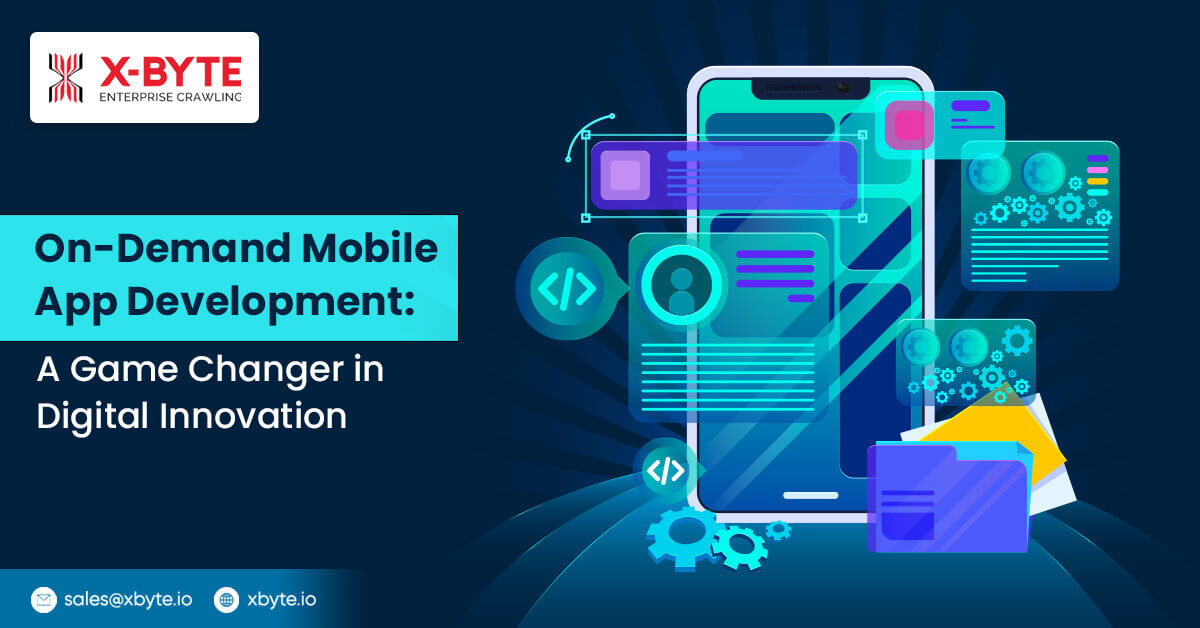
The digital era is rapidly evolving with technological advancements and shaping how people work and interact with the world. From AR/VR technology to smart assistance, mobile apps are becoming prominent in delivering intuitive experiences. These apps have defined the meaning of convenience and altered business processes to offer goods and services.
A recent and revolutionary trend is the rise of on-demand mobile app development. These applications have transformed our daily lives by providing a dynamic ecosystem, from taxi services to food delivery and even home services.
What is On-Demand Mobile App Development?
On-demand mobile app development is creating mobile applications that provide instant access to routine products, services, or information using modern technology.
X-Byte is an on-demand mobile app development company with expertise in developing applications to meet the requirements and expectations of users by providing quick and convenient access to various services and resources. On-demand service mobile app development has become popular because of its user-friendliness and efficient solutions across sectors.
Why On-demand Service Mobile Apps Are Popular?
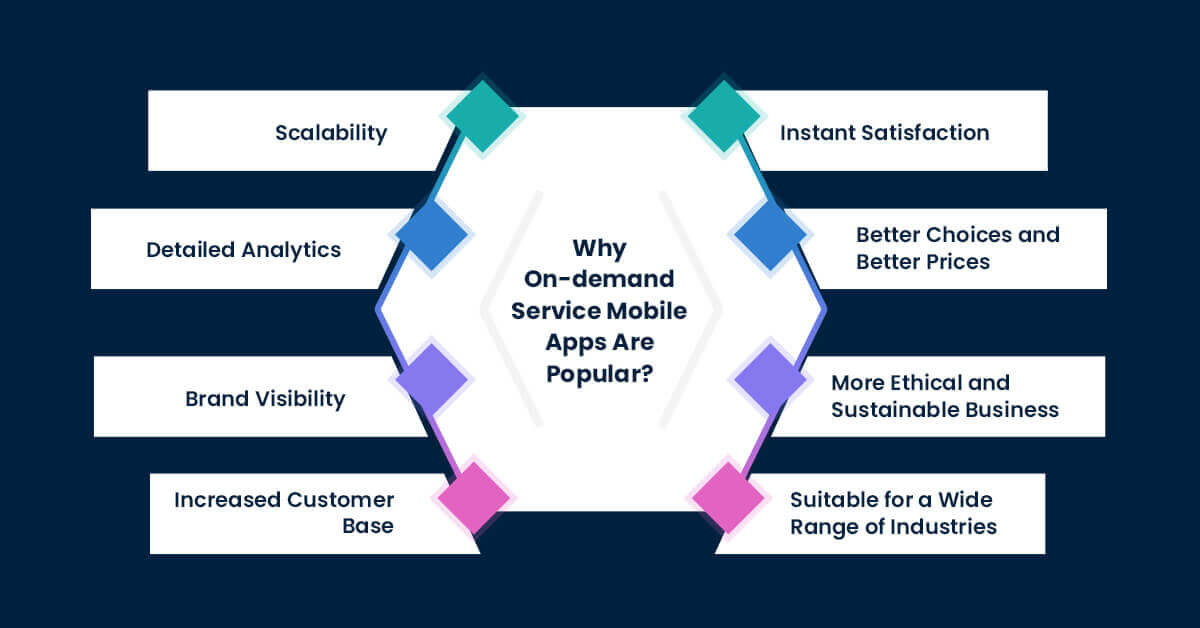
On-demand mobile app development companies have gained popularity due to their ability to meet the demands of each individual. As mobile users keep growing, users expect to get what they need at nearly any given moment by tapping a few times on the mobile screen.
Instant Satisfaction
On-demand app development is one of the prominent ways to satisfy users’ expectations. Users can use the application to satisfy their routine requirements offered by several service providers. Through an app for a specific service, users can expect instant communication with their preferred company to receive the needed services. With on-demand mobile applications, users can leverage services or products businesses offer with a single click and quickly deliver them to their doorstep.
For example, using our on-demand food delivery app, users expect to get their meals delivered soon after they place their order, or in the case of our on-demand doctor app, they usually schedule their consultation in advance.
Better Choices and Better Prices
X-Byte provides custom on-demand mobile app development for your business, or it may come in a full-proof marketplace where users can compare prices, buy products, and grab offers from several service providers. Our on-demand marketplace always has a rating for each company, so customers can filter and search to make a fully informed decision and choose the best option.
More Ethical and Sustainable Business
On-demand service mobile app development solutions are essential to the ethical and sharing economy, which is more eco-friendly than the traditional economy. Due to its quality, on-demand service mobile apps for iOS and Android are considered ethical and trustworthy.
For example, ridesharing services meet core on-demand business characteristics and, at the same time, are a more sustainable solution compared to on-demand taxi apps.
Suitable for a Wide Range of Industries
With changing market conditions, there is an opportunity to provide on-demand services for almost any industry. X-byte, the best on-demand mobile app development company, provides apps to assist various business segments. For example, beauty on-demand apps, demand TV apps and even on-demand laundry and car wash applications. And there are not the only on-demand service app benefits.
Scalability
Without having any prime goal for your business, you can initially start your on-demand mobile app development with us for a single segment. Furthermore, with time, you can have other divisions on board and turn your business into an on-demand app marketplace.
Detailed Analytics
With the analytics module in our apps, businesses can get a detailed report of their customers, including their search behavior, purchase order, customer navigation, etc. Hence, businesses can determine what services their customers are fond of and most popular among them by analyzing the gathered data. This helps businesses improve their solutions' performance and provide improved customer service.
Brand Visibility
Having just an online presence through the website is not the right solution in this competitive era. On-demand mobile app development for your business is a futuristic solution that takes your online presence to the next level.
Increased Customer Base
Service providers can take a commission from each transaction on their on-demand marketplace, resulting in significant revenue. As a result, our on-demand mobile app development services can help businesses enhance customer retention and grow their businesses.
Key Features of On-Demand Apps
Mobile app development on-demand is based on an intuitive yet effective model. It links customers needing services with service providers (such as restaurants, couriers, drivers, handymen, etc.). Key features include:
Push Notifications
It is essential to inform customers about limited-period offers or other services. There are options, such as you can select message notifications to alert the consumers; it functions as a valuable marketing tool as well.
Also, you can use them for sending some real-time status concerning any requests as well as letting them know regarding the changed status of the request.
GPS Tracking
For tracking the order, GPS integration is vital as it is a key feature in on-demand apps. It has a key role in building an On-Demand application, as it can conveniently let the customers acknowledge the advancement of the placed orders.
Activity List
It displays the customer's orders, search results, and other relevant data for a complete reference. In this manner, the application takes the load off the customers to again regather everything.
Wishlist
Sometimes, a situation arises when the users are not ready to purchase a product or the items they are searching for are out of stock. So, in that case, the on-demand apps have this feature to save items in the wishlist, as it is quite essential. It would motivate the customers to purchase whenever they’re ready or when the product is back in stock.
Multiple Payment Options
Currently, the concept of a mobile payment facility plays an essential role. Also, the chances of getting your on-demand app are more acceptable, and its use also depends on the diverse payment options.
Ratings and Reviews
The reviews and client testimonials are the main reason for the success of on-demand applications. As they assist you in enhancing the user experience as well as the quality of an app.
Booking Cancellation
There can be several situations when the customer must cancel the order for some reason. So, it is the facility that allows them to either cancel or reschedule the booking as per their preferences.
Place Multiple Orders
It is an excellent option to offer the customers as this facility is vastly recommendable as a customer can place various orders at once at the store. So, entire apps must gather the customer's basic information, which can assist with a simplified checkout process for each order placed.
Types of on-demand service apps
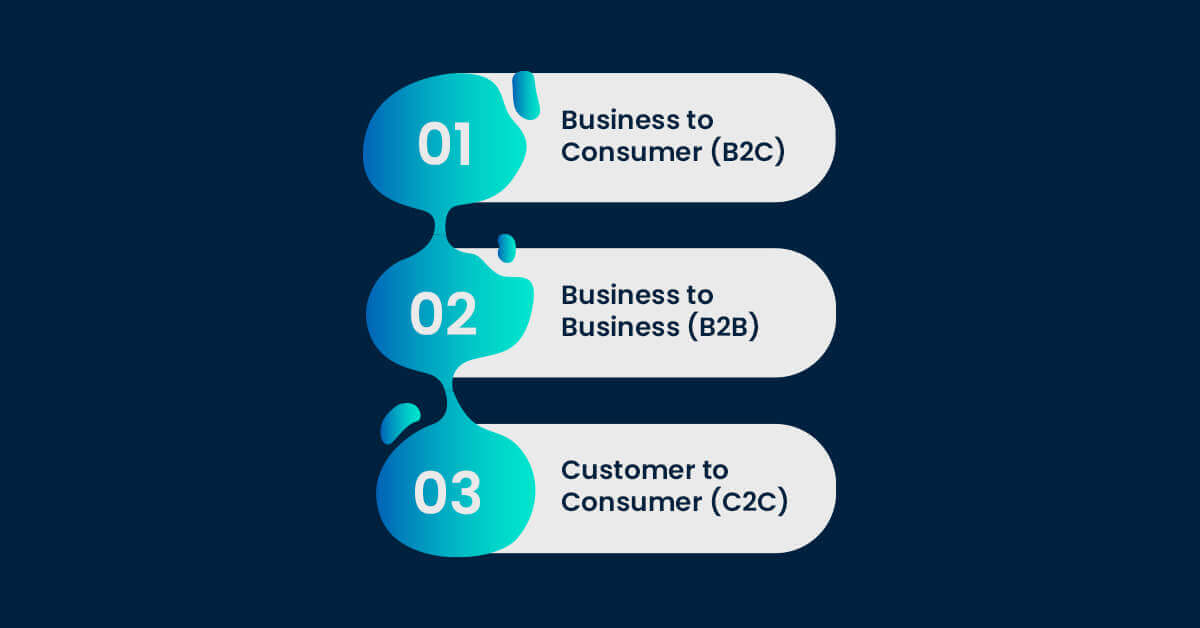
Business to Consumer (B2C)
Business to Consumer (B2C) on-demand delivery apps permit the direct provision of goods or services from businesses to end-users. This type of applications is used by certain eateries such as Domino's and Starbucks to service its customers.
Business to Business (B2B)
B2B on-demand delivery systems are frequently utilized to provide services by linking other businesses directly for logistics or to carry out their operations. B2B on demand applications are typically involved with assisting other businesses with their operations and logistics.
Customer to Consumer (C2C)
Customer to Consumer (C2C) applications are used by service providers and users to sell or acquire things directly from another customer. C2C on demand delivery applications with a million daily users include Flipkart, Etsy, and Amazon.
Depending on the services they offer and the sectors they target, there are several on-demand mobile applications. The following are a few typical categories of mobile apps that are available:
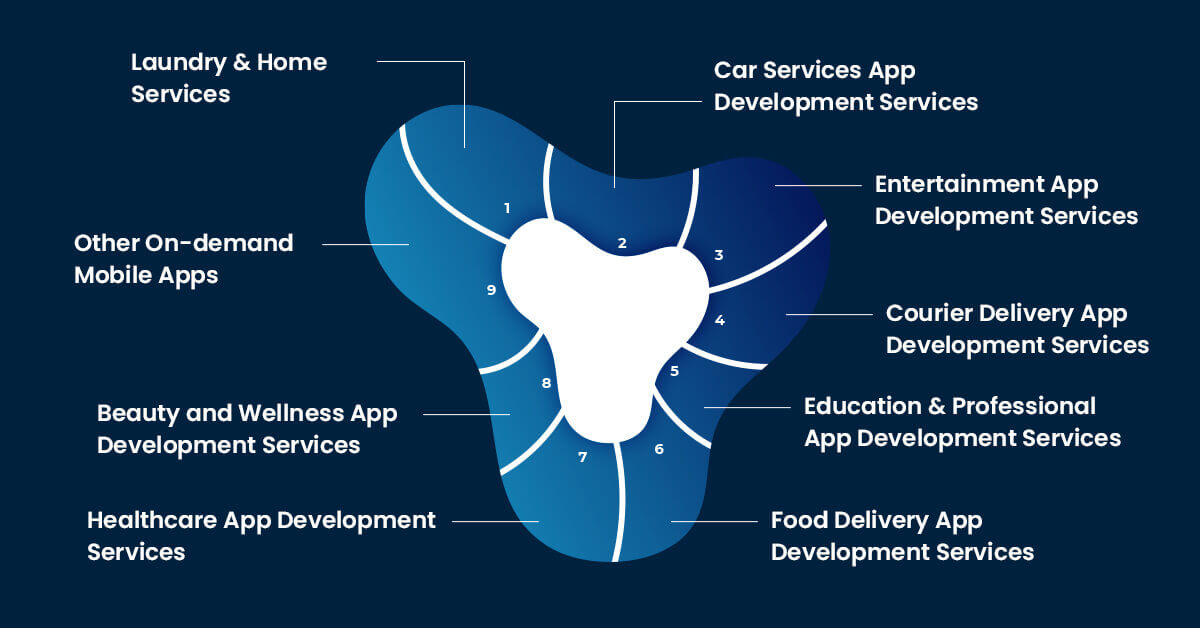
1. Laundry & Home Services:
On-demand Laundry and Dry-Cleaning Apps
Users can schedule pickup and delivery of their laundry and dry-cleaning through these apps. Rinse and Cleanly are examples in this category.
On-demand Home Services Apps
Home service platforms connect users with service providers for tasks like home repairs, cleaning, or assembly. Users can describe their needs, receive quotes, hire a service provider through the app, and complete payments within the platform.
2. Car Services App Development Services
On-demand Car Repair Apps
On-demand car services offer options for car maintenance, repair, and cleaning, often with mobile mechanics who come to the user's location.
Ride Sharing Apps
Ride-sharing apps connect passengers with drivers in real time. Users can request a ride through the app, and nearby drivers receive the request. Once a driver accepts, users can track their driver's location, pay for the ride through the app, and provide ratings and reviews.
3. Entertainment App Development Services
On-demand Event and Entertainment Tickets Apps
These apps allow users to purchase event tickets, such as concert or movie tickets, often with e-ticketing options.
4. Courier Delivery App Development Services
Storage and Moving Services Apps
Users can request on-demand storage solutions and moving services to handle their belongings. Companies like PODS and U-Haul offer such services.
On-demand Logistics and Delivery Apps
These apps cater to businesses and individuals seeking delivery and courier services. Users can request package pickup and drop-off services, and they can access real-time tracking to monitor the status of their deliveries.
5. Education & Professional App Development Services
Tutoring and Learning Apps
On-demand educational apps connect students with tutors for various subjects and skills. Platforms provide educational support and offer various educational courses to students.
On-demand Professional Networking Apps
Professional networking platforms connect freelancers with businesses and individuals seeking various services. Users can post job listings or proposals, communicate with freelancers, and manage payments securely.
6. Food Delivery App Development Services
On-demand Food Delivery Apps
Food delivery apps partner with local restaurants to offer users a convenient way to order food. Users can browse menus, place orders, track deliveries, and pay for their meals within the app. The delivery person picks up the orders and brings them to the customer's location.
On-demand Grocery Delivery Apps
Grocery delivery apps allow users to select groceries and other essentials from local stores. A shopper picks and packs the ordered items, and a delivery person delivers the order to the doorstep. Users can schedule deliveries or receive them within their convenient hours.
7. Healthcare App Development Services
On-demand Healthcare Services Apps
Telemedicine apps enable users to consult with medical professionals through video calls or chat. Users can request a consultation and book an appointment, provide a medical history, and receive a diagnosis or prescription and medicines, all without leaving their homes.
8. Beauty and Wellness App Development Services
On-demand Beauty Apps
On-demand beauty apps allow users to book beauty and wellness services at their chosen location and convenience. Users can schedule appointments for hair, makeup, massages, and self-grooming. Service providers arrive equipped to provide the requested services at customers' homes.
9.Other On-demand Mobile Apps
On-demand Home Rental and Accommodation Apps
The home rental and accommodation app connects hosts with travelers seeking accommodations. Hosts list their properties, and travelers can browse, book, and pay for stays directly through the app. This offers a more personalized and flexible alternative to traditional hotels.
On-demand Pet Care Apps
Pet care apps allow pet owners to schedule dog walking, pet sitting, and other pet care services. Users can book a pet sitter, receive updates on their pets, and handle payments through the app.
| On-Demand App Development Categories | Trending On-Demand Apps |
|---|---|
| Laundry and Dry-Cleaning Apps | Hamperapp, Poplin, Cleanly |
| Car Repair Apps | RepairBuddy, Simply Auto |
| Entertainment and Ticket Apps | TickPick, Disney+ |
| Beauty and Wellness Apps | Mindbody, Fresha, Vagaro |
| Healthcare Services Apps | Medscape, Zocdoc, Amwell |
| Home Service Apps | TaskRabbit,Handy |
| Car Booking Apps | Lyft, WingZ |
| Food Delivery Apps | DoorDash, ChowNow, Uber Eats |
| Education Apps | Duolingo |
| Pet Care Apps | PetDesk |
| Logistics and Delivery Apps | FedEx, USPS, DHL |
| Home Rental and Accommodation Apps | Trulia, Vrbo |
| Professional Networking Apps | Upwork, Fiverr |
How to build a successful on-demand service app?
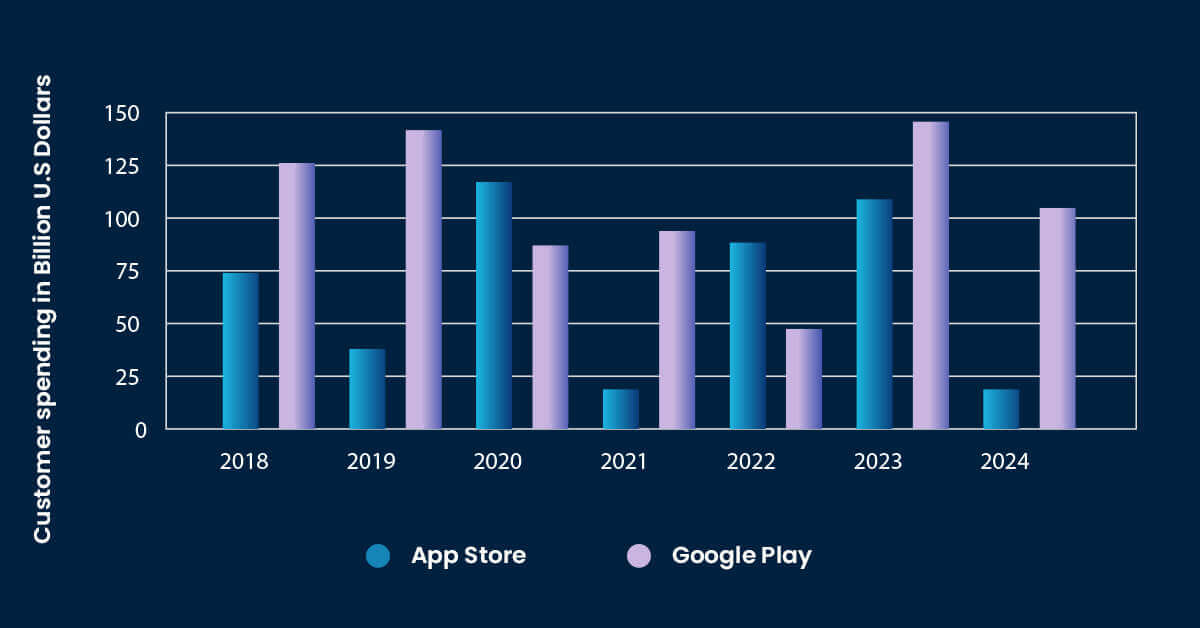
The procedure for developing an on-demand solution is identical to that of developing any other program, with the exception that it integrates the on-demand methodology. You will, of course, be operating in a very competitive sector. However, there is still space for further expansion because on-demand solutions are still relatively new and in high demand.
The following steps should be considered while thinking about creating an on-demand application:
Market Research and Idea Validation
- Identify a Niche: Look for underserved or overlooked niches in the market. Finding a specific segment that has unmet needs can be a crucial differentiator.
- User Personas: Create user personas to understand your target audience better. Know their preferences, behaviors, and pain points.
- Competitive Analysis: Study existing competitors to identify gaps or areas where you can offer something unique. Assess their strengths and weaknesses.
Define Your Business Model
- Revenue Model: Decide how you'll make money. Standard models include commission fees (taking a percentage of transactions), subscription plans, advertising, or a combination.
- Pricing Strategy: Determine how you'll price services. Consider dynamic pricing, surge pricing during peak times, and any promotional or loyalty programs.
- Partnerships: Explore partnerships with local businesses, service providers, or other platforms to expand your service offerings.
Legal and Regulatory Compliance
- Legal Structure: Register your business and ensure it complies with local laws and regulations.
- Data Privacy: Implement strong data privacy and security measures to protect user data. Comply with data protection regulations like GDPR or CCPA.
Create a Business Plan
- Mission and Vision: Define your app's mission, vision, and values, which will guide your business decisions.
- Financial Projections: Develop financial forecasts, including revenue, expenses, and profitability estimates.
- Marketing Strategies: Lay out a detailed plan for marketing and user acquisition, including digital marketing, partnerships, and social media strategies.
- Growth Plans: Define how you intend to scale and grow your app, including expansion into new regions or adding new features.
Wireframing and Design
- Wireframes and Prototypes: Create wireframes and prototypes to visualize the app's structure and flow. This is a critical step for UX and UI design.
- UI/UX Design: Design a user-friendly and visually appealing interface. Focus on making the app intuitive and easy to navigate.
Development
- Technology Stack: Choose the appropriate technology stack for your app. Decide whether to use native (iOS and Android), hybrid, or cross-platform development.
- Backend Development: Develop the server-side components, including the database, APIs, and servers that handle data and user interactions.
- Security: Prioritize security measures to protect user data and payment information. Implement encryption and secure authentication.
Real-Time Tracking and Geolocation
- GPS Integration: Implement GPS and geolocation features to enable real-time tracking of service providers and users.
- Optimization: Optimize location accuracy and minimize battery consumption for users and service providers.
Payment Gateway Integration
- Secure Payment Gateways: Integrate secure and widely accepted payment gateways to handle transactions safely.
- Multiple Payment Methods: Offer multiple payment methods, including credit cards, digital wallets, and cash payments, to cater to a broader user base.
User Reviews and Ratings
- Feedback System: Implement a robust review and rating system that allows users to provide feedback and ratings for service providers.
- Reporting Mechanism: Include a reporting system for users to report inappropriate behavior, issues, or safety concerns.
Testing and Quality Assurance
- Testing Phases: Conduct thorough testing, including functional testing to ensure all features work as expected, usability testing to assess the user experience, performance testing to handle traffic, and security testing to identify vulnerabilities.
- Bug Fixing: Identify and fix any bugs or issues discovered during testing.
Launch and Marketing
- Soft Launch: Initially launch your app in a limited geographic area to test functionality, gather user feedback, and make necessary improvements.
- Marketing Strategy: Plan a marketing strategy for your official launch, including online advertising, influencer partnerships, and social media campaigns.
- App Store Optimization (ASO): Optimize your app store listings (e.g., App Store, Google Play) with relevant keywords and appealing visuals.
Maintenance and Updates
- Regular Updates: Continuously update your app to add new features, improve performance, and fix any bugs that arise.
- Technology Trends: Stay current with technology trends and industry changes to remain competitive.
On-Demand Service App Development Cost
Depending on several variables, creating an app for an on-demand service might vary significantly in price. It is essential to comprehend these elements to estimate and control the development expenses.
The following are the main variables that impact how much developing an on-demand service app costs:
App Complexity
A significant pricing factor is the intricacy of your application. Apps that are simple and have basic functionality will cost less than those that are complicated and include sophisticated features like real-time tracking, payment integration, and customized user interfaces.
Platform (iOS, Android, Both)
Generally speaking, it is more expensive to create for both iOS and Android than for just one. Coding and testing must be done separately for each platform.
Design and User Interface
A professionally created, user-friendly application with unique visuals and animations will come at a higher price than one that is simple or template-based.
Functionality and Features
The amount and complexity of features, like messaging, alerts, geolocation, user profiles, and payment processing, will determine how much development will cost. Including third-party services or adding special features may also raise expenses.
Integration with Third-Party Services
Development and license fees may increase if your app has to be integrated with third-party services, such as social media platforms, mapping services, or payment gateways.
Security Measures
It could take more time and money to build robust security features that safeguard user information and transactions.
| Type of Application | Cost Estimation |
|---|---|
| Simple On-demand Apps | $25,000 to $1,15,000. |
| Medium On-demand Apps | $1,15,000 to $2,00,000. |
| Complex On-demand Apps | $2,00,000 to $2,95,000 |
| Customer Side Apps | $15,000 to $50,000 |
| Service Panel | $15,000 to $49,000 |
| Admin Panel | $20,000 to $80,000 |
Conclusion
The introduction of on-demand mobile app development has completely changed how we obtain goods and services. We may anticipate that the on-demand market will expand into new sectors as technology upgrades drastically change how we work and live.
Remaining inventive, attentive to consumer input, and dedicated to quality are critical for success in this cutthroat market. As a result, whether an end user is looking for a more convenient way to meet needs or an entrepreneur with a game-changing idea.
Frequently Asked Questions
How do on-demand mobile apps differ from traditional apps?
Mobile applications that can be downloaded on demand are a game-changer for obtaining goods and services. These applications, which let users request services with a single swipe, are about speed and convenience. On-demand applications match users with the closest service providers—whether they're looking for a handyman, a taxi, or food using real-time data and location monitoring. On-demand applications are becoming a necessary component of modern living due to their immediacy, integrated payment methods, and user evaluations, completely changing consumer expectations and whole businesses.
Traditional applications, on the other hand, have a greater range of uses. Apps range from productivity applications to social networking, gaming, and information resources; they are flexible and only sometimes have an immediate service delivery goal. They might not require face-to-face encounters with service providers and don't usually rely on-location services to the same degree. In our fast-paced, always-on environment, on-demand applications have completely changed the way we access and use services, even if both kinds of apps have a role in the mobile ecosystem.
What future trends are expected in on-demand mobile app development?
On-demand mobile app development has a bright future as technology keeps improving. Observe the following trends:
- Growth into New Sectors:
- Integration with Emerging Technologies:
- Sustainability:
- Global Reach:
It is anticipated that on-demand applications will penetrate further sectors, introducing convenience to hitherto untapped markets, including pet care, home remodeling, and legal services.
To improve user experiences, expect to see on-demand apps combined with cutting-edge technologies like artificial intelligence (AI), virtual reality (VR), and augmented reality (AR).
As environmental awareness grows, on-demand applications may prioritize sustainability by providing eco-friendly delivery methods and more environmentally friendly modes of transportation.
The use of on-demand apps is not restricted to any one region. They want to persist in broadening their worldwide outreach, facilitating individuals' access to global services.
What are the benefits of on-demand mobile app development?
Benefits Of On-demand Service Apps To Businesses
- Adaptability and dynamic
- On-demand service applications generally remain economical
- Clearly defined scalability scopes in the future
- Extremely secure on-demand apps
- Promotes possible growth
- Allows users to provide input
Benefits Of On-demand Service Apps To Customers
- Systems of ordering with ease
- Order tracking in real-time
- One-click order and cancellation
- Adaptable and error-free payment gateways
- Interest-free payments
- Less annoying push alerts
Why should you invest in on-demand app development?
- Increase in prime efficiency
- Larger customer base
- Ease of doing business
- Real-time tracking
- Infrastructure cost reduction
- Cashless payment option
- Cost-effective business model
- Security
